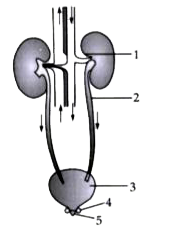Draw a labelled diagram of the longitudinal section of a flower.
Step-by-Step Solution for Drawing a Longitudinal Section of a Flower
1. Draw the Outline of the Flower: Start by sketching the general shape of the flower. This includes the petals, sepals, and the reproductive structures in the center.
2. Add the Sepals: At the base of the flower, draw the sepals. These are typically green and leaf-like structures that protect the flower bud before it blooms.
3. Draw the Petals: Above the sepals, draw the petals. These are usually colorful and attract pollinators. Make sure to give them a distinct shape and color.
4. Sketch the Stamen: The stamen is the male reproductive part of the flower. It consists of two main components:
- Anther: Draw the anther as a bilobed structure at the tip of the stamen. This is where the pollen grains (male gametes) are produced.
- Filament: Draw a thin stalk-like structure connecting the anther to the base of the flower.
5. Draw the Pistil: The pistil is the female reproductive part of the flower and consists of three main parts:
- Stigma: At the top of the pistil, draw the stigma, which is the sticky part where pollen grains land.
- Style: Below the stigma, draw the style as a slender tube connecting the stigma to the ovary.
- Ovary: At the base of the style, draw the ovary, which is usually bulbous in shape. This is where the female gametes are produced and where fertilization occurs.
6. Label the Parts: Clearly label each part of the flower in your diagram:
- Sepals
- Petals
- Stamen (with Anther and Filament)
- Pistil (with Stigma, Style, and Ovary)
7. Final Touches: Review your diagram for accuracy and clarity. Make sure all parts are labeled clearly and that the drawing is neat.
- Anther: Draw the anther as a bilobed structure at the tip of the stamen. This is where the pollen grains (male gametes) are produced.
- Filament: Draw a thin stalk-like structure connecting the anther to the base of the flower.
- Stigma: At the top of the pistil, draw the stigma, which is the sticky part where pollen grains land.
- Style: Below the stigma, draw the style as a slender tube connecting the stigma to the ovary.
- Ovary: At the base of the style, draw the ovary, which is usually bulbous in shape. This is where the female gametes are produced and where fertilization occurs.
- Sepals
- Petals
- Stamen (with Anther and Filament)
- Pistil (with Stigma, Style, and Ovary)
Topper's Solved these Questions
Similar Questions
Draw a well labelled diagram of the longitudinal section of a pistil showing pollen germination .
View SolutionDraw a labelled diagram of the longitudinal section of the maize grain to show the structure of mature embryo.
View SolutionDraw a labelled diagram of a neuron
View SolutionDraw a labeled diagram of sperm.
View SolutionDraw a labeled diagram of sperm.
View SolutionDraw a labelled diagram of a neuron.
View SolutionDraw a labelled diagram of human ovum.
View SolutionThe diagram given below represents an organ system in the human body. Study the same and answer the questions that follow:

Draw a neat, labelled diagram showing the longitudinal section of part 1.
View SolutionDraw a labelled diagram of a nephron.
View Solution(a) Descibe a labelled diagram of longitudinal section of an anatropous ovule.
(b) Which cell of the ovule gets transformed into megaspore mother cell?
View Solution